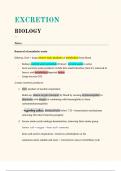Summary
excretion topic summary
- Institution
- OCR
a brief summary of excretion : excretory organs, liver and kidney structure, kidney transplant, kidney failure, pregnancy testing, anabolic steroid testing. diagrams for structure of liver and kidney bullet points to summarise sequence of events in excretion key words highlighted for better r...
[Show more]



